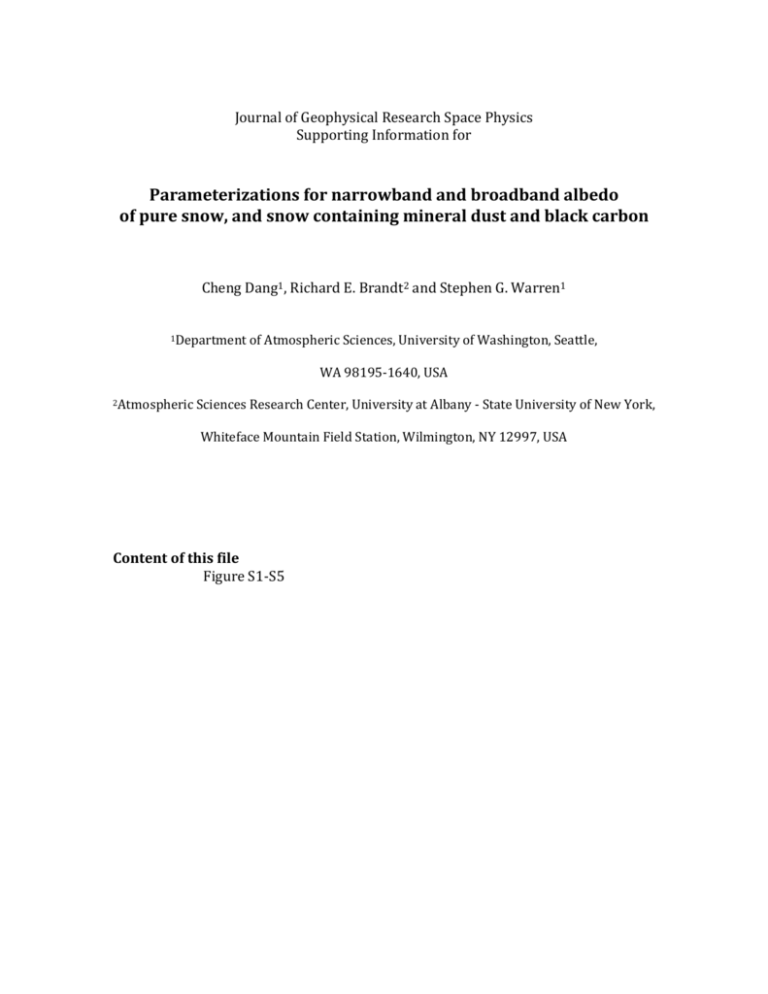jgrd52140-sup-0001-supinfo
advertisement

Journal of Geophysical Research Space Physics Supporting Information for Parameterizations for narrowband and broadband albedo of pure snow, and snow containing mineral dust and black carbon Cheng Dang1, Richard E. Brandt2 and Stephen G. Warren1 1Department of Atmospheric Sciences, University of Washington, Seattle, WA 98195-1640, USA 2Atmospheric Sciences Research Center, University at Albany - State University of New York, Whiteface Mountain Field Station, Wilmington, NY 12997, USA Content of this file Figure S1-S5 Figure S1. Single-scattering quantities for pure snow: (a) Extinction efficiency Qext; (b) single-scattering coalbedo 1- ; (c) asymmetry parameter g; Figure S2. Errors in broadband albedo reduction induced by using BC-snow albedo reduction parameterization suggested in Section 5.2. The dashed curves, solid curves, and asterisks show errors of albedo reduction in three different ranges of BC mass fraction listed in Table 1. Different colors are different snow grain radius ranges from 5 – 2500 μm as indicated in the right bottom corner. Figure S3. Evaluation of albedo reduction calculated using BC equivalent factor f (snow containing only dust). Top panels: the solid curves are broadband (all wave and visible) albedo reduction calculated using DISORT for different snow grain radius and dust mass fraction; the dots are broadband albedo reduction calculated using parameterization of BC-snow albedo reduction suggested in Section 5.2 and corresponding BC equivalent mass fraction for given dust mass fraction. Bottom panels: absolute error of broadband albedo reduction induced by using parameterization and BC equivalent mass fraction. Figure S4. Evaluation of albedo reduction calculated using BC equivalent factor f (snow containing both BC and dust, allwave band, snow grain radius r = 100 μm and 1000 μm). Top panels: the solid curves are allwave-broadband albedo reduction calculated using DISORT for different snow grain radius and mixture of BC and dust mass fractions; the dots are broadband albedo reduction calculated using parameterization of BC albedo reduction suggested in Section 5.2 and corresponding BC equivalent mass fraction for given amount of dust and BC mixture. Bottom panels: absolute error of broadband albedo reduction calculated using parameterization and BC equivalent mass fraction. Figure S5. Evaluation of albedo reduction calculated using BC equivalent factor f (snow containing both BC and dust, visible, snow grain radius r = 100 μm and 1000 μm). Top panels: the solid curves are visible-broadband albedo reduction calculated using DISORT for different snow grain radius and mixture of BC and dust mass fractions; the dots are broadband albedo reduction calculated using parameterization of BC albedo reduction suggested in Section 5.2 and corresponding BC equivalent mass fraction for given amount of dust and BC mixture. Bottom panels: absolute error of broadband albedo reduction calculated using parameterization and BC equivalent mass fraction.